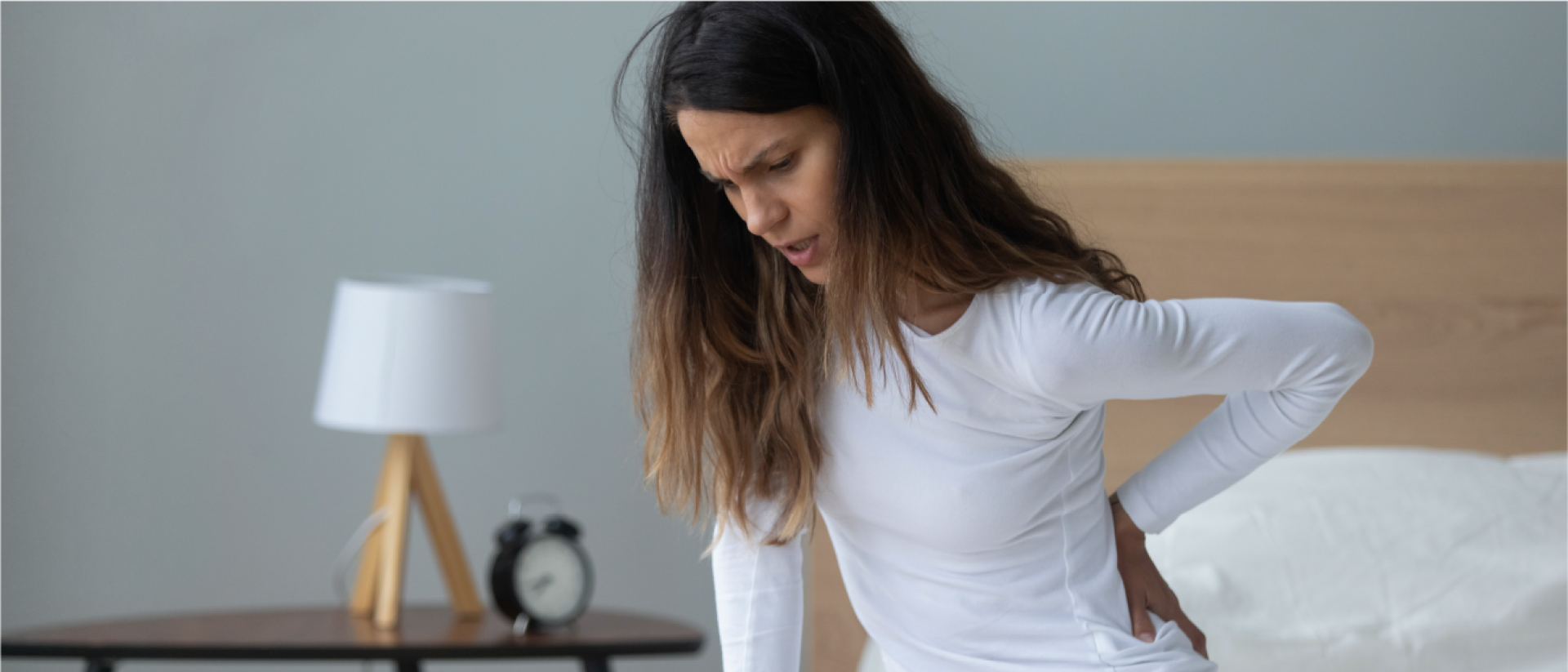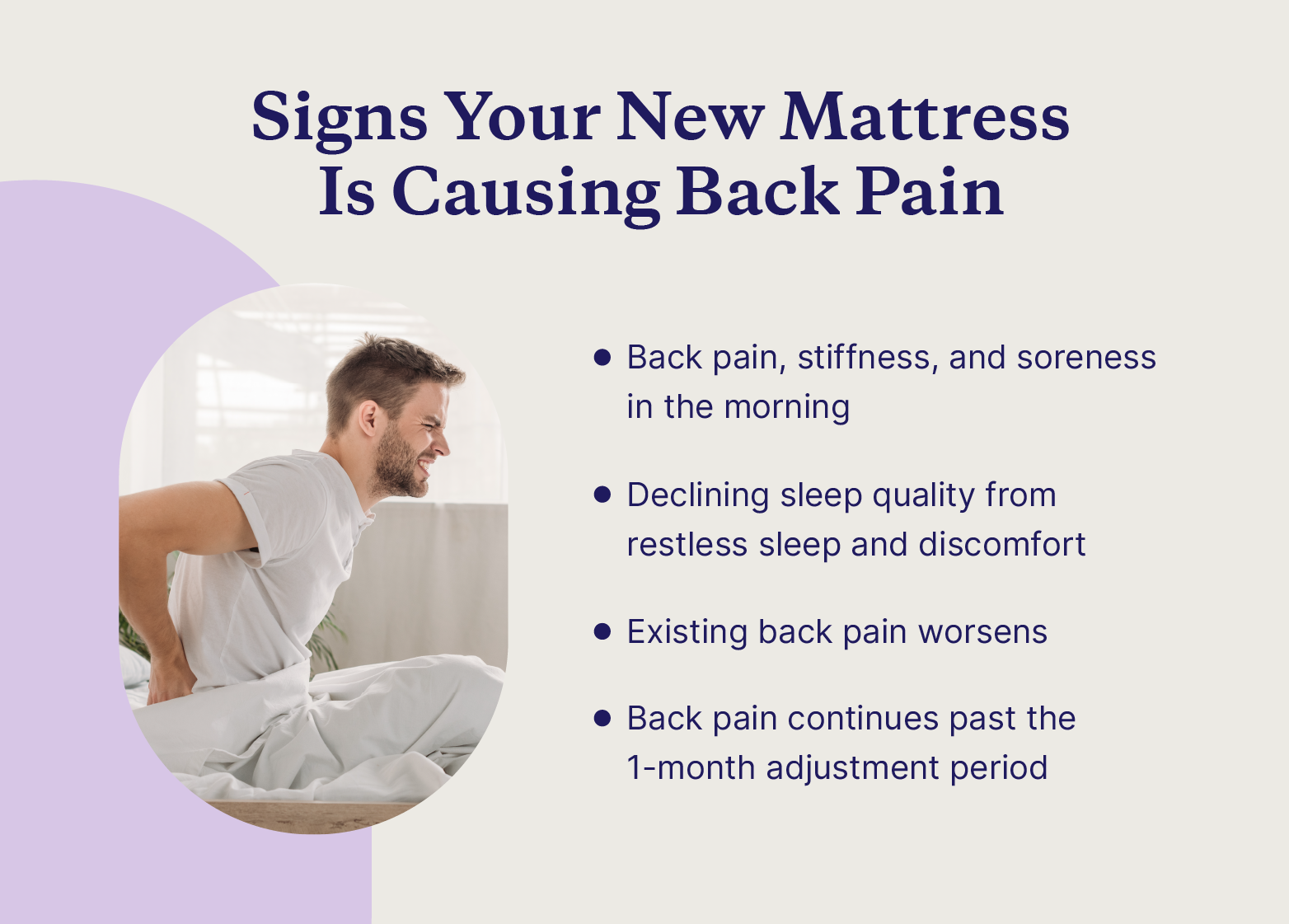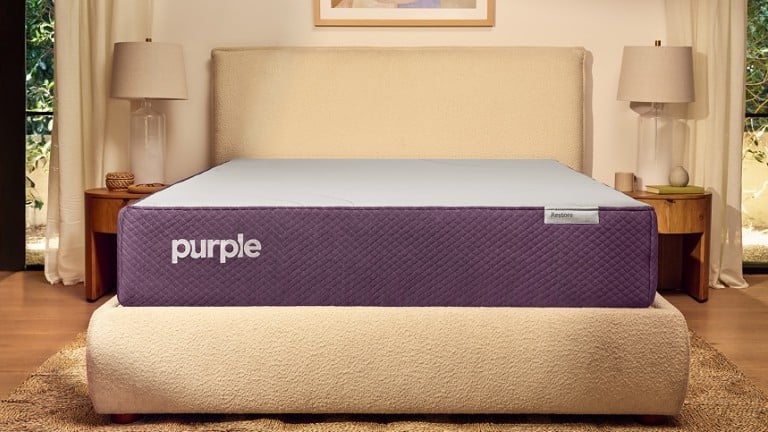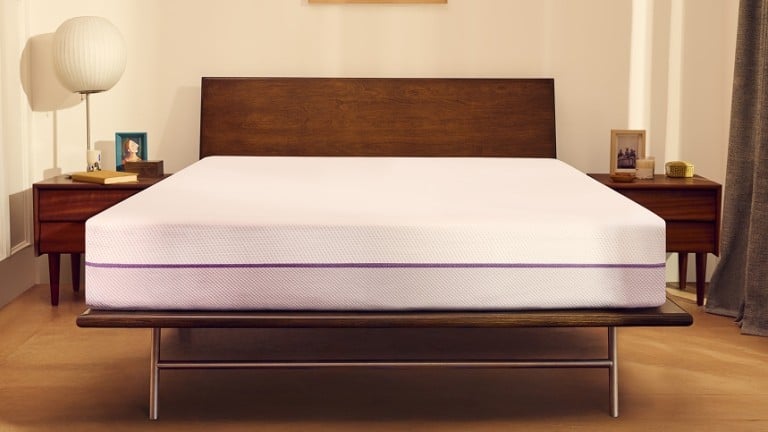
Is Your New Mattress Giving You Back Pain? Why & How To Fix It
Key Takeaways:
- Your new mattress may cause back pain due to the initial adjustment period.
- Insufficient support from the mattress and base type may also be the cause.
- Investing in a high-quality mattress and adding pillows for extra support may alleviate new mattress back pain.
More than 600 people worldwide were affected by low back pain (LBP) in 2020, a figure that is projected to rise to more than 800 million by 2050.1 Low back pain is a major sleep disturbance that can either be exacerbated or improved by your mattress. Dr. Vanessa Hill, a sleep scientist and public educator, says, "Some researchers have called for a clearer distinction between pain and discomfort. Discomfort is an unpleasant feeling that's typically milder and shorter – like waking up with morning aches or perhaps a kink in your neck. Pain is typically more intense, may be associated with tissue damage and could warrant medical attention."2
If you have pre-existing back pain that has worsened or have experienced new back discomfort since investing in a new mattress, you’re in the right place.
This post will go over the signs that your bed may be contributing to your back pain and guide you on choosing the right mattress. Additionally, you’ll find details on equipping your mattress with the right base, toppers, and pillows to support your back for a restful night's sleep.
Signs Your New Mattress Is Causing Back Pain
If you’re consistently waking up feeling sleepy or uncomfortable, or you have back pain that subsides gradually throughout the day, your mattress may be a factor. You may also find that getting comfortable in bed has been increasingly difficult since purchasing your new mattress or your existing back pain has gotten worse. If you can date these physical symptoms since the day of purchase, your mattress could be a cause.
Your Mornings Start With Back Pain, Stiffness, and Soreness
If you wake up with pain, stiffness, and soreness in your back, and the feeling gradually goes away through the day, your mattress may be a factor. Discomfort doesn’t have to be limited to the back — it can also extend to other parts of your body. Some additional symptoms that may suggest your mattress is involved include:
- Neck, shoulder, and hip pain from poor alignment
- Joint stiffness if your mattress doesn’t support neutral sleeping positions
- Numbness and tingling from reduced circulation
These symptoms can also vary depending on your sleeping position. Different sleeping positions tend to work better with different mattress firmness levels. Below are ideal mattress firmness levels based on sleeping position:
Back sleepers: Medium-firm
Medium to firm mattresses help maintain proper spinal alignment and support the natural curve of the lower back. Memory foam, latex, or hybrid mattresses with a balanced firmness level can be good options for back sleepers.
Side sleepers: Medium-soft
Side sleepers need a mattress that offers good pressure relief, especially at the shoulders and hips. A softer mattress with adequate cushioning, such as a memory foam or latex mattress, can contour to the body's curves and help reduce pressure points.
Stomach Sleepers: Firm
Stomach sleepers typically need a firmer mattress to prevent their midsection from sinking too deeply, which can strain the spine. Innerspring or hybrid mattresses with a firmer feel are often suggested for stomach sleepers.
Your Sleep Quality Is Suffering
If you start noticing a decline in your sleep quality, such as more restless sleep, it could be due to physical discomfort from your mattress. Some symptoms of sleeping on a bad mattress that are associated with poor sleep quality include:
- Increased irritability and mood swings
- Difficulty concentrating
- Impaired memory
While physical pain, stiffness, and soreness may occur from an unsupportive mattress, your cognitive function can also be affected when your sleep quality declines. Your brain needs sufficient, uninterrupted sleep to do its job, so consider whether it’s time to replace your mattress if it’s getting in the way of restorative sleep.
Existing Back Pain Worsens
If you already have some degree of back pain and you notice that it worsens after sleeping on your new mattress, this may suggest a mattress-related issue. The mattress shouldn’t exacerbate existing back problems but should instead provide relief.
In addition to your existing back pain, if you experience increased stiffness, persistent and more intensified discomfort, and the pain radiating to different parts of your back, it may be time to seek advice from a medical professional. You may also consider changing your mattress.
It’s Been Over a Month
There is often an adjustment period when you get a new mattress. You can generally start to adjust within a month, but if you’re still experiencing pain, stiffness, and soreness after this period, it may be a sign that your body is not well suited to the mattress.
If within one month you have experienced the following, your new mattress may be a bad match for your sleeping needs:
- Decreased comfort as it becomes harder to fall asleep
- Increase tossing and turning as your mattress provides little to no support
- Worse sleep quality from interrupted sleep
Why Your New Mattress Causes Back Pain
Your new mattress can be a mismatch for you for various reasons. Mattresses should provide support to the natural contours of your body and accommodate multiple sleeping positions. The adjustment period after getting a new mattress may have you experiencing a change in support and sleeping positions to get comfortable which may sometimes lead to temporary back discomfort.
Mattress Isn’t Supportive Enough
Your mattress should provide spinal and edge support, and even weight distribution unique to your body and sleeping preferences. If you feel your mattress isn’t serving one of the below purposes, it may not be the right fit for you.
- Spinal alignment: The mattress should conform to the body's natural curves and not cause the spine to bend or twist into unnatural positions, especially when learning how to sleep on your back. This means it needs to be responsive enough to meet different sleeping positions while keeping the spine supported.
- Edge support: This is the support along the edges of your mattress and determines how well it can accommodate those who sleep near the edge of the mattress. It should feel just as supportive as the center, prevent you from rolling off, and provide ease in getting in and out of bed.
- Even weight distribution: A supportive mattress will distribute the sleeper's weight evenly across the bed. This helps promote better circulation for your limbs.
Mattress and Base Don’t Pair Well
The base, or mattress foundation, lies under the mattress and gives it support, elevation, and weight distribution. Not all bases are created equal, and you may be using the wrong base for your mattress. Some common base and mattress compatibilities include:
Box Spring
These bases are made of wood or metal and contain layers of coil covered in fabric.
- Compatibility: Innerspring mattresses
Platform Bed
These are made of wood and metal and provide a flat support. They are the most compatible base for mattresses.
- Compatibility: Innerspring, memory foam, latex, and hybrid mattresses
Slatted Base
These are made of wood and metal and consist of slats (narrow flat planks of wood/metal) horizontally laid across the frame to create a platform. If slats are too far apart, the mattress can start to sag or dip in the areas where support is lacking. This uneven support doesn't just damage the mattress; it can also lead to discomfort or back pain for the user due to improper spinal alignment.
- Compatibility: Innerspring, memory foam, latex, and hybrid mattresses
Adjustable Base
This is a motorized platform that can be adjusted with a remote. Individuals who experience sleep apnea, acid reflux, or poor circulation often opt for this type of base.
- Compatibility: Innerspring, memory foam, latex, and hybrid mattresses
Whether it’s due to the coils piercing through worn fabric or slats spaced too far apart, your mattress base can possibly compromise your mattress support, so it’s important to double-check if you’re using the right base for your mattress.
Low-Quality Mattress
You can determine the quality of your mattress by its support, comfort, durability, and materials. If your mattress exhibits any of the characteristics below, it may be contributing to your back pain:
- Durability: Mattress wear and tear can lead to sagging and indentation. This uneven surface can cause soreness and stiffness over time.
- Materials: Lower-grade materials, like low-density foams, degrade more easily. As foam degrades, so does its breathability, increasing the chances of overheating during sleep.
- Comfort: Your mattress can’t adequately support your sleeping positions and you find yourself tossing and turning throughout the night to get comfortable. Lack of proper cushioning can increase pressure points in the body, leading to stiffness.
How To Fix Your Mattress Causing Back Pain
Now that you have an idea of the signs and reasons why your new mattress may be contributing to your back pain, aches, and stiffness, it’s time to consider solutions. Depending on your specific needs, you may need to invest in a new mattress or frame or rely on mattress add-ons like pillows and toppers.
"When we sleep well, we’re more emotionally stable, alert, and our working memory runs more smoothly. Even modest improvements in our nighttime sleep can translate into better energy and daytime functioning, which we can really feel the next day!” — Dr. Vanessa Hill
Let’s take a look at some solutions below.
1. Invest in a High-Quality Mattress
There are many high-quality mattresses to choose from for those seeking to reduce mattress-related back discomfort. Four mattress types to consider are:
- Hybrid: This type of mattress consists of a blend of two or more materials such as coils with foam layers. This combination is designed to provide balanced support and added breathability, which can make it a strong option when searching for the best mattress for lower back support. Purple’s RestorePlus® Hybrid provides increased responsiveness to pressure and motion and offers enhanced breathability with the addition of our proprietary GelFlex Grid®.
- Latex: These mattresses are generally made of synthetic foam. They come in various firmness levels depending on whether it's a full or partial latex mattress. These mattresses are known for their durability, with many lasting up to twenty years or more.
- Memory foam: These mattresses consist of viscoelastic foam (memory foam), which gives it a viscous, slow response to pressure. This mattress type adheres to body contours and comes in various densities.
- Innerspring: This traditional mattress utilizes coils within layers of fabric. This mattress is breathable and offers a buoyant sleep surface.
Type | Details | Benefits | Considerations |
Hybrid | Made of multiple materials Usually consists of innerspring coils with layers of foam or latex | Balanced support and comfort Motion isolation Temperature regulation Durable | Tends to be more expensive due to complex design Generally heavier than other mattress types |
Latex | Made of synthetic foam Comes in various firmness levels Can be a hybrid mattress | Durable Motion isolation | Tends to be expensive if opting for a hybrid configuration Generally heavier than other mattress types Emits a rubbery odor in the beginning that fades over time |
Memory Foam | Made of viscoelastic foam Adheres to natural contours of the body Comes in various thicknesses and densities | Pressure relief Motion isolation Allergen resistant | Less breathable than other mattress types Sinking feeling may feel uncomfortable |
Innerspring | Made of coil springs within layers of fabric | Bouncy and responsive surface Temperature regulation Most affordable | Less motion isolation less durable Less pressure point support |
2. Use a Mattress Topper
Mattress toppers are removable padded layers you can place on top of your mattress. They add comfort through extra cushioning and can relieve your body’s pressure points. They are especially useful in making a firm mattress softer.
Mattress toppers come in different sizes, thicknesses, densities, and firmness levels. You should also consider the materials depending on your sleep goals. Mattress toppers are not recommended with Purple mattresses because they limit the benefits of the GelFlex Grid® such as pressure point relief, back and limb support, and temperature balance, to name a few.
- Memory foam: This material provides contouring comfort and pressure relief — ideal for those with pressure point issues or body pain.
- Latex: Latex offers both support and comfort. Natural latex is durable and hypoallergenic.
- Gel-infused: This type of material offers cooling properties to help regulate body temperature during sleep.
3. Consider Upgrading to an Adjustable Bed Frame
Adjustable bed frames come with a motorized mechanism you can control with a remote to adjust the position and angle of the bed. You can adjust sensitive areas that support the head, feet, and back.
Adjustable bed frames can accommodate most types of mattresses aside from older innerspring mattresses. They are widely beneficial but are especially ideal for:
- Individuals with sleep apnea, acid reflux, or back pain
- Elderly individuals
- Recovering medical patients
4. Use Pillows for Extra Support
There are also situations where extra support is what makes the difference in comfort. Pillows can provide the extra support you need to feel more comfortable and help reduce back discomfort.
One useful way to utilize pillows for comfort is to place them according to your sleeping positions. Let’s look at some useful placements below:
- Back sleepers: Behind the knee and under the arm for proper head and neck alignment
- Side sleepers: Between the knees and under the arm to reduce pressure on the lower back
- Stomach sleepers: Low loft pillow under your stomach to reduce strain on the lower back and maintain spinal alignment
- Combination sleepers: Body pillow to hug when you’re side sleeping or place under the knees for spinal support
5. Rotate or Flip Your Mattress
Depending on the type of bed you have, rotating your mattress regularly can evenly distribute wear and tear, giving you more consistent support and pressure relief. Check your manufacturer's guidelines before flipping or rotating your mattress to avoid voiding your warranty or damaging your bed.
Wake Up Refreshed With Purple
A new mattress is a long-term investment in your sleep quality and overall well-being, so it can feel disheartening when you find your new mattress isn’t meeting your expectations. Purple offers quality mattresses to accommodate your individual needs and promises a 100-night trial so you can feel confident with your selection.
In a recent sleep study with SleepScore Labs, The Chronic Pain Sleep Inventory showed a 63% average reduction in the impact of pain on sleep interference when sleeping on a Purple Restore mattress compared to when participants slept on their original mattress3.
Look to Purple to find the perfect mattress to support your back and relieve aches and pain.
FAQ
Is It Normal To Have Back Pain With a New Mattress?
It’s normal to experience some temporary discomfort like slight aches and soreness for a short time, but if this pain persists for longer than a month, it may suggest a mismatch between you and the mattress. Some things you can check for to determine the source of your back pain include:
- Mattress type: Check if your mattress type matches with its base.
- Firmness: Determine if the firmness is within your comfort level.
- Material: Examine if the material quality can conceal discomfort from coil springs.
How Long Does It Take a Body To Adjust to a New Mattress?
It generally takes a month to adjust to a new mattress, though that time can vary depending on several factors, including:
- Body adaptation: If your new mattress is very different from your previous one, you may require additional time to adapt to the new mattress.
- Underlying health issues: If you have health issues like sleep apnea or joint stiffness, your adjustment period may take longer, especially if your mattress isn’t specially designed for your condition.
Can a Too-Firm Mattress Cause Back Pain?
Yes, too-firm mattresses can contribute to back discomfort and even worsen existing issues. While mattress firmness is a matter of personal preference, there are multiple reasons why back pain can occur or worsen due to firmness levels:
- Lack of pressure relief: A very firm mattress might not give enough support to side sleepers as hips and shoulders lack padding.
- Spinal misalignment: Very firm mattresses may not conform very well to the natural curvature of the spine.
More to Explore
Level-up your sleep routine with our most-loved products.





